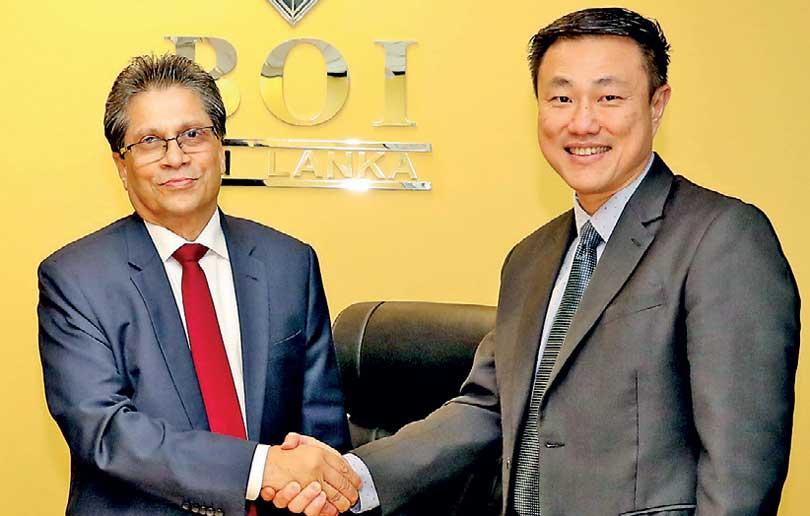15 Nov 2019 - {{hitsCtrl.values.hits}}

BOI Chairman Mangala Yapa and Sugih Energy International (Pte) Ltd. Director Danny Lee after signing the agreement
By NIshel Fernando
Sri Lanka’s Board of Investment (BOI) has approved US$ 36.4 billion worth foreign direct investment (FDI) projects so far this year including a US$ 24 billion oil refinery and petrochemical complex in Hambantota, which is set to become the largest FDI project in the country’s history.
Singapore-based Sugih International (Pte) Ltd is the principal investor of the mega project, which will process around 21 million tonnes of petrochemical material or around 420,000 barrels per day once it’s commissioned during the next 2-5 years.
The BOI signed the agreement with Hambantota Oil Refinery (Pvt) Ltd, an associate company of Sugih International yesterday.
Addressing a media briefing at the BOI premises yesterday, its Chairman Mangala Yapa revealed that US$ 8-9 billion export revenue is envisaged once the refinery is in full operation while generating 6, 500 direct employment opportunities for Sri Lankans ranging from medium to high-end skill levels.
The initial phase will involve the commissioning of the petroleum refinery with plans to develop a petrochemical complex in subsequent phases.
“Hambantota is located between users of Far East and oil producers of Middle East, Therefore, we feel that Hambantota is ideally located and that will have many cascading opportunities for Sri Lanka,” Yapa said.
As the International Maritime Organization’s (IMO) new regulations will come into force banning ships from using fuels with sulphur content of above 0.5 percent from January 2020, compared to the current 3.5 percent rate, he noted that the BOI has been actively targeting foreign investors to Hamabantota by capitalising on this opportunity.
“There’s no bunker fuel available of that quality and specification at the moment. That’s where the new refinery opportunity is seen,” he stressed.
The BOI officials emphasised that the project is a catalyst investment, which will boost liquid cargo shipments to the Port of Hambantota, thereby resulting in added revenue in foreign currency from inward/outward movement of ships carrying crude oil and finished products.
In addition, the BOI believes that the refinery will also enable the transformation of the port as a marine bunker port, taking full advantage of its proximity to international maritime routes.
The project company is currently evaluating short-listed consultancy firms to carry out the Environmental Impact Assessment (EIA) for the project.
“An internationally renowned consultancy agency will be appointed to conduct the comprehensive EIA compliant with the TOR issued by the CEA. Further, the EIA will be augmented with a health and safety assessment to ensure enhanced sustainability of the project,” Yapa noted.
The government has allocated 2, 200 acres in close proximity to the Hambantota port for investments in the petrochemical sector.
The BOI also approved US$ 8.53 billion worth of FDIs consisting of 65 manufacturing projects, five agriculture projects, six infrastructure projects, four knowledge services projects and four utility projects including expansions of existing projects.
However, the BOI expects that FDI inflows to Sri Lanka would fall to US$1.5 billion this year, below the initial target of US$ 3 billion, due to the impacts of Easter Sunday attacks, the 52-days of political instability and the upcoming presidential polls.
During the first half of the year, Sri Lanka attracted estimated US$ 700-800 million in FDIs.
However, Yapa pointed out that cumulative FDI inflow to Sri Lanka from 2016 to the third quarter of 2019 accounted for 31 percent of the country’s total FDI stock of US$18.16 billion since 1978.
He was optimistic that the country will be able to surpass the US$3 billion FDI mark next year.
15 Nov 2024 28 minute ago
15 Nov 2024 49 minute ago
15 Nov 2024 1 hours ago
15 Nov 2024 1 hours ago
15 Nov 2024 2 hours ago